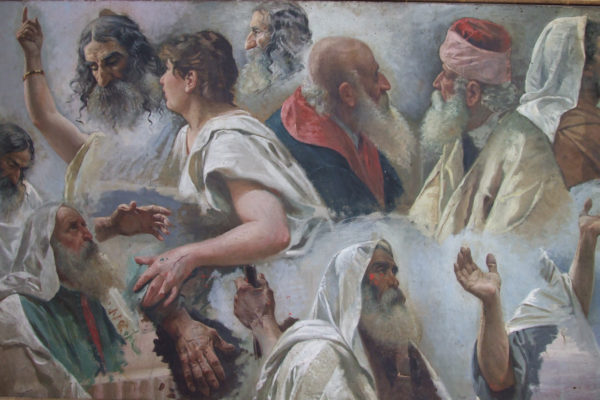The presence of the standard of Siena (the black-and white shield known as the Balzana) and the style of clothing indicate a subject connected with the history of the city in the sixteenth century, perhaps recounted in a novel or short story from the Romantic period, which could be identified as the story of the “Beautiful Marsilia.” During their raids in the Mediterranean, in 1543 Turkish pirates led by the terrifying Barbarossa came to the fortress of Collecchio, in the territory of Magliano, which belonged to the noble Marsili family of Siena. They conquered the castle and kidnapped Margherita Marsili, Nanni’s beautiful sixteen-year-old daughter, to hand her over to the sovereign Suleiman the Magnificent. He was enchanted by her red hair and charming demeanor, to the point of naming her his favorite and having sons with her who reigned after him. Still today, a tower along the coast of the Monti dell’Uccellina bears the name of the “Bella Marsilia.”
An Episode from Sienese History (“The Beautiful Marsilia”?)
1
Pietro Aldi
Manciano, 12 July 1852 – 18 May 1888
Born into a family of wealthy landowners, Pietro Aldi in 1864 enrolled in the Istituto di Belle Arti in Siena, directed by Luigi Mussini. He won the triennial competition in 1873 and the following year, with The Defeat of Conrad of Swabia at Tagliacozzo, won a Biringucci fellowship from the Società di Esecutori di Pie Disposizioni in Siena which enabled him to study in Venice, Florence, and Rome, where he worked with Cesare Maccari. In 1876 he sent The Adulteress to Siena as an example of his studies, but in early 1877 he was forced to return to Manciano because of ill health, a problem that unfortunately would become frequent.
In 1878 he presented in Rome Buoso da Dovara, which was a great success. In 1880 he painted The Virgin and Child Appearing to St. Paul of the Cross for the convent of the Passionist Fathers on Mount Argentario. That same year, he did The Funeral of Pompey the Great, shown in Turin in 1881, and in 1883 participated in the international show in Rome with The Final Hours of Sienese Liberty, to critical acclaim; that same year, he frescoed two funerary chapels in the Misericordia Cemetery in Siena: The Intercessory Angels in the Pollini chapel and Charity in the Franci chapel. The following year he painted St. Joseph with the Christ Child for the church of San Nicola in Sorano and finished two large pictures for Pitigliano cathedral with important moments from the life of Pope Gregory VII.
In 1886, in the Risorgimento Room of the Palazzo Pubblico in Siena, he painted The Meeting at Vignale and the very famous Meeting at Teano. Two years later he presented a large-scale painting of The Triumph of Judith now in the Vatican Museum. At the same time he began work on the canvas of Nero Watching Rome Burn, intended to be shown at the 1889 International Exposition in Paris, but it remained unfinished at his death.
Andrea Granchi
Florence, 11 June 1947
After graduating from the Accademia di Belle Arti in 1969, Andrea Granchi debuted with large-scale paintings and was one of the first in Italy to make art films, curating also a number of international art film festivals during the 1970s. He presented films and art works in the Venice Biennale in 1978 and 2011, the Milan Trienniale in 1981, and the Rome Quadrienniale in 1986, following by numerous other, more recent participations.
Since the late 1970s, in painting Granchi focuses on themes of travel, shadow, and giants, as a complex metaphor for existence striving to master values and sublime ideas, presented in a personal neo-Romantic, visionary and narrative artistic language. In 1990-1991, his stint as a substitute teacher in the Accademia’s School of Decoration led him to rediscover fresco painting, which he adapted to a three-dimensional effect that enabled him to create unprecedented accords between painting and sculpture. Since 1992 Granchi teaches at the Accademia in Carrara, at first decoration but then painting since 1995, a position he later held also at the Accademia in Florence. Besides teaching, he also works at restoration, which he learned from his father and practiced with him for many years. Both in the anthology exhibition held in the Pinacoteca Civica in Volterra and in his most recent show in 2019 in the museum of sacred art in Abbadia San Salvatore, the artist presented a selection of works carefully chosen to set up a dialogue as equals with the masterpieces of the past on view in those museums.



